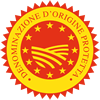Description
Prosciutto Toscano PDO is a raw and cured charcuterie product obtained through the processing of fresh legs from Italian heavy pigs belonging to the Italian Large White, Landrace and Duroc breeds or other breeds considered compatible.
Production Area
The production area of Prosciutto Toscano PDO is within the entire territory of the Tuscany region. The pigs used for production must be born, reared and slaughtered in the regions of Emilia-Romagna, Lombardy, The Marches, Umbria, Lazio and Tuscany.
Production Method
The legs are refrigerated for at least 24 hours and then trimmed with a curved blade, which leaves a ridge of meat that does not protrude more than 8 cm from the head of the femur at the end of the curing process. The trotter, rind and internal fat are removed with a V cut that enables the salt to penetrate the meat. The legs are then dry salted with salt, pepper and fresh herbs; the process must last long enough to ensure a good level of dehydration. This is followed by the “sugnatura”, which involves the exposed area of meat being covered with a mixture of pork fat, rice flour, salt, pepper and fresh herbs. The curing process, from salting to the product being put on the market, must last at least 10 months for legs of ham with a final weight of between 7.5 and 8.5 kg, and at least 12 months for hams weighing over 8.5 kg. Prosciutto Toscano PDO destined to be sold in slices or in packets must be cured for a further two months, which means at least 12 months if it weighs between 7.5 and 8.5 kg, and at least 14 months if weighing over 8.5 kg. If the ham conforms to the characteristics required for the PDO, it is fire-branded with the mark.
Appearance and Flavour
Prosciutto Toscano PDO has a rounded shape; it is curved at the top and weighs between 8 and 9 kg. When sliced, the colour ranges from vivid to light red, with a very small amount of inter-muscular fat. It has a delicate taste, with just the right amount of sapidity, and a characteristic aroma deriving from the long curing process and dry-salting with salt, pepper and typical herbs from the area.
History
The history of Prosciutto Toscano PDO dates back to the Etruscans. There were already regulations for pork processing in the time of Charlemagne. However, it wasn’t until the 15th century, under the rule of the Medicis, that all the production stages became standardised, with regulations that are still in force today, which you could say were a sort of product specification ante litteram. In the same century, the Ufficiali di Grascia (literally translated as the Officers of Grease), an elected body of Florentine tradesmen, were appointed to control the application of “right pricing” and to monitor the observance of the production regulations.
Gastronomy
Prosciutto Toscano PDO should be kept in a cool place, with the cut end covered with cling film or foil. It can be eaten on its own, but it pairs excellently with unsalted Pane Toscano PDO; it is characterised by a lower moisture content than other hams, which accentuates its sapid flavours, at the same time making it particularly suitable for combining with sweet, juicy fruits such as melon, kiwi, pineapple, and figs.
Marketing
The product is marketed as Prosciutto Toscano PDO. It is sold whole, deboned or boned, in pieces or sliced, unpackaged, or in suitable containers or sealed food-grade packets.
Distinctive Features
The region’s climate has influenced the trimming method used for Prosciutto Toscano PDO, which creates a wider “V” shape to facilitate the penetration of the salt. Its distinguishing strong flavour is due not only to the salt, but also to the use of typical Tuscan fresh herbs and extracts, such as garlic, rosemary, juniper and myrtle.

































